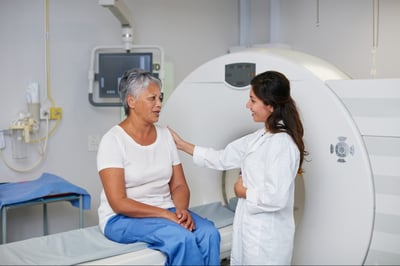Study: Yearly breast MRI screening improves outcomes for women with inherited BRCA mutations
Summary
An international research study of yearly breast MRI screening among women with BRCA1 and BRCA2 gene mutations found that BRCA1 carriers who had MRI screenings were less likely to die of breast cancer than those who did not. Additional studies with more BRCA2 mutation carriers are needed to determine if yearly breast MRIs reduce deaths from breast cancer in this group. (Posted 6/24/24)
Este artículo está disponible en español.
Printer Friendly Page Read the Original Article
RELEVANCE
Most relevant for: People with a BRCA1 or BRCA2 mutation who are considering breast MRI screening.
It may also be relevant for:
- people with breast cancer
- previvors
- people with a genetic mutation linked to cancer risk
Relevance: Medium-High


Strength of Science: Medium-High


Research Timeline: Human Research


What is this study about?
This international study looked at whether yearly breast screening reduces the risk of death from breast cancer among women with a or mutation. Researchers compared the number of deaths due to breast cancer among mutation carriers who had regular breast MRI screenings to those who did not.
Women with a BRCA1 or BRCA2 mutation have a very high risk for breast cancer. Expert guidelines outline three main options for managing this risk:
- risk-reducing mastectomy
- medication to lower risk (e.g., tamoxifen)
- increased surveillance using a combination of and MRIs
These guidelines vary by country. In the United States, the National Comprehensive Cancer Network (NCCN) creates guidelines for cancer screening, prevention and treatment. The NCCN recommends yearly breast MRI screening beginning at age 25 for people with a BRCA1 or BRCA2 mutation. Therefore, it is important to know if breast MRIs reduce the risk of death from breast cancer among mutation carriers.
Most study participants received increased screening by adding a yearly breast MRI to their other screenings to detect cancer early.
Study findings
The study involved 2,488 women (people assigned female at birth) from 59 centers in 11 countries. Among these women, 2,004 had a BRCA1 mutation, while 484 had a BRCA2 mutation. Most participants (1,756: 1,442 BRCA1 and 314 BRCA2 mutation carriers) had at least one screening MRI. The remaining 732 women (562 BRCA1 and 170 BRCA2 mutation carriers) did not have breast MRIs.
Follow-up began when participants entered the study (at age 30 or older). The average follow-up time was just over nine years.
Throughout the study:
- 344 women developed breast cancer. Of these:
- 241 had breast MRIs.
- 103 did not have breast MRIs.
- 35 died from their disease.
Among the women who died of breast cancer:
- 21 did not have breast MRIs.
- 18 had a BRCA1 mutation.
- 3 had a BRCA2 mutation.
- 14 had breast MRIs.
- 12 had a BRCA1 mutation.
- 2 had a BRCA2 mutation.
Breast MRI significantly reduced deaths from breast cancer in BRCA1 mutation carriers. Unfortunately, due to study limitations, including a small sample size, more research of women with BRCA2 mutations is needed to better understand how breast MRI screening impacts death from breast cancer.
Overall, this study showed that the risk of death by age 75 due to breast cancer was 20.5 percent for those who did not undergo MRI surveillance, compared to 5.5 percent for those who did.
FORCE offers many peer support programs for people with inherited mutations.
- Our Message Boards allow people to connect with others who share their situation. Once registered, you can post on the Diagnosed With Cancer board to connect with other people who have been diagnosed.
- Our Peer Navigation Program will match you with a volunteer who shares your mutation and situation.
- Our moderated, private Facebook group allows you to connect with other community members 24/7.
- Check out our virtual and in-person support meeting calendar.
- Join one of our Zoom community group meetings.
Updated: 08/06/2022